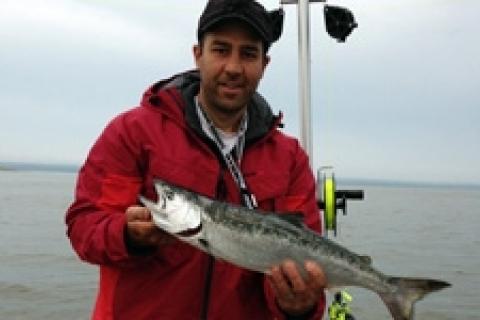
 If weather conditions are keeping you off your favorite rivers, there always is a second option to catching fish with flies. Although most of the fun with fly fishing is in the casting and presentation of flies to fish, there is something very satisfying about tying your own patterns and catching fish, even if that means having to troll them behind your boat. Trolling flies might not be an option for everybody but if you have a boat and access to lake that allows trolling, then this could be a great way to catch trout, salmon, pike and bass.
If weather conditions are keeping you off your favorite rivers, there always is a second option to catching fish with flies. Although most of the fun with fly fishing is in the casting and presentation of flies to fish, there is something very satisfying about tying your own patterns and catching fish, even if that means having to troll them behind your boat. Trolling flies might not be an option for everybody but if you have a boat and access to lake that allows trolling, then this could be a great way to catch trout, salmon, pike and bass.
In essence trolling fly patterns are creations that try and best imitate what fish are looking to feed on. In almost all cases trolling flies are recreations of baitfish with the exception of a few squid patterns. These flies are designed to be submerged and presented to fish as a moving target. The design of these flies should be done with an understanding of what is needed for these flies to be successful. Trolling flies above all else have to swim well and be flashy enough to catch a fish's eye.
A lot of times fly tiers get caught up in creating super realistic looking patterns (like dry flies) but this really isn't what's important with trolling flies. Using colored materials that that imitate the baitfish you are trying to match is a good start, but adding flash and sparkle will get the attention you are looking for. Depending on how deep you plan on fishing these flies, there might not be much light penetration so finding the brightest shades of the colors you plan on using is also a good idea. Visibility is determined by light waves that color re-emits. Fluorescent colors in greens, pinks and oranges re-emit the longest light waves and can be seen greater distances in darker water conditions. Trolling fisherman can take advantage of this color phenomenon by choosing material colors with the most light emission to increase the visibility of fly patterns.
Lake trolling flies are tied with a variety of materials but mostly synthetics seem to work best. Materials like polar hair, EP fibers, flashabou are great body materials because they add a lot of bulk without weight. These materials mat down when in the water and create great baitfish profiles as they move. Epoxy is a standard with these types of patterns for building up heads and attaching eyes. Not only is epoxy a good adhesive for binding materials and bullet proofing flies it can also be used to create distinct characteristic for flies (swimming lips and specific body shapes).
As far as size is concerned, flies have to match what they intend on catching. If you are planning on fishing for big predatory fish, trolling flies need to be big enough to be tempting and have enough hook to hold a fish. Hooks in sizes 2 or bigger are the norm with size 6 or 8 stinger hooks attached if patterns are over five inches. Most patterns that I have seen the best success with are in the 4-6 inch size range.
Fishing trolling flies is done the in the same manner as other trolling bait. You can flat line these flies behind the boat or run them behind dipsy divers or down riggers if you are targeting fish down deep.
These flies can be a fun way to spend an afternoon chasing fish that you might not normally devote too much time fishing. Trolling flies can be a fun twist on a on productive way to catch fish.
- 4409 views

